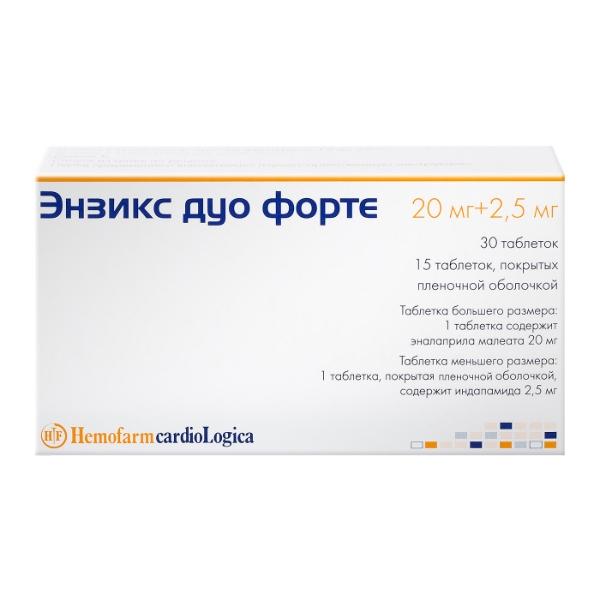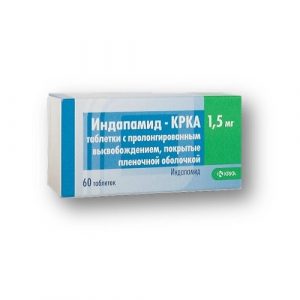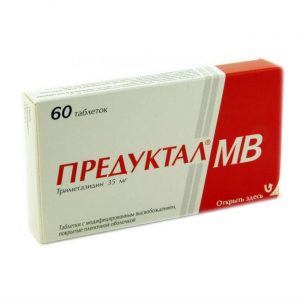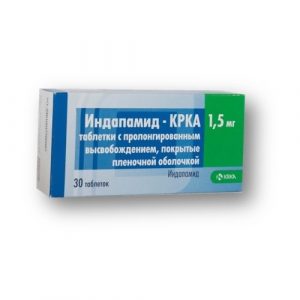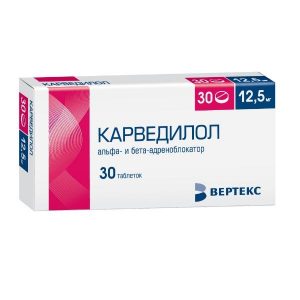Description
Release form
ENZIX DUO FORTE, tablets set: indapamide, film-coated tablets 2.5 mg + enalapril, 20 mg tablets.
10 tablets of enalapril and 5 tablets of indapamide in an Al / Al blister laminated with PVC and polyamide film. 3 blisters with instructions for use in a cardboard pack.
Packing
10 tablets of enalapril and 5 tablets of indapamide in an Al / Al blister, Laminated with PVC and polyamide film. 3 blisters with instructions for use in a cardboard pack.
Contraindications
The preparation Enzix duo forte includes lactose monohydrate. The drug should not be used in patients with lactose intolerance, lactase deficiency, glucose-galactose malabsorption.
enalapril
Hypersensitivity to enalapril and other ACE inhibitors, a history of angioedema associated with treatment with ACE inhibitors, hereditary or idiopathic angioedema, simultaneous use with aliskiren and / or aliskiren-containing drugs in patients with diabetes mellitus and / or moderate or severe impaired renal function (glomerular filtration rate (GFR) less than 60 ml / min / 1.73 m ), pregnancy, period of breastfeeding, age up to 18 years (efficacy and safety not established).
Use with caution in case of primary hyperaldosteronism, bilateral renal artery stenosis, conditions accompanied by a decrease in circulating blood volume (BCC) (including vomiting, diarrhea), single kidney artery stenosis, hyperkalemia, condition after kidney transplantation, aortic stenosis, mitral (with impaired hemodynamic parameters), hypertrophic obstructive cardiomyopathy, renovascular hypertension, systemic diseases of the connective tissue (systemic lupus erythematosus, scleroderma, etc.), coronary heart disease, cerebrovascular disease, diabetes mellitus, renal failure (proteinuria more than 1 g / day), liver failure, a history of allergic or angioedema in patients, in patients that adhere to a diet with a restriction of sodium chloride or are on hemodialysis while taking it with immunosuppressants, saluretics, potassium-sparing diuretics, drugs to Leah, potassium-containing salt substitutes and lithium drugs during apheresis procedures low density lipoprotein (LDL aferaza) using dextran sulfate, during desensitization by venom of hymenopteran insects in patients of the Negroid race in patients after major surgical interventions or during general anesthesia in patients undergoing dialysis using high-flow membranes (such as AN 69В®) in elderly patients (over 65 years old).
Indapamide
Hypersensitivity to the drug, other sulfonamide derivatives or other components of the drug, anuria, refractory hypokalemia, severe liver failure (including encephalopathy) and / or severe renal failure (creatinine clearance less than 30 ml / min), pregnancy , the period of breastfeeding, age up to 18 years (effectiveness and safety have not been established).
With caution is prescribed for diabetes mellitus in the stage of decompensation, hyperuricemia (especially accompanied by gout and urate nephrolithiasis), impaired liver and kidney function, impaired water-electrolyte balance, hyperparathyroidism in debilitated patients or in patients receiving combination therapy with other antiarrhythmic drugs, while taking drugs that extend the QT interval.
Use during pregnancy and lactation
The drug is contraindicated in pregnancy and lactation.
Special instructions
The simultaneous use of enalapril and indapamide leads to an increase in the antihypertensive effect of enalapril.
Enalapril
Symptomatic arterial hypotension
Symptomatic arterial hypotension is rarely observed in patients with uncomplicated arterial hypertension. In patients with arterial hypertension taking enalapril, arterial hypotension develops more often against the background of dehydration, which occurs, for example, as a result of diuretic therapy, restriction of salt intake, in patients on dialysis, as well as in patients with diarrhea or vomiting (see sections “Side effect” “Interaction with other drugs”). Symptomatic arterial hypotension was also observed in patients with heart failure with or without renal failure. Arterial hypotension develops more often in patients with severe chronic heart failure with hyponatremia or impaired renal function, in which higher doses of “loop” diuretics are used. In these patients, treatment with enalapril should begin under medical supervision, which should be especially careful when changing the dose of enalapril and / or diuretic. Similarly, patients with coronary heart disease or cerebrovascular diseases in whom an excessive decrease in blood pressure can lead to the development of myocardial infarction or stroke should be monitored.
When developing arterial hypotension, the patient should be laid down and, if necessary, inject 0.9% sodium chloride solution. Transient arterial hypotension when taking enalapril is not a contraindication to further use and increasing the dose of the drug, which can be continued after filling the volume of fluid and normalizing blood pressure.
In some patients with heart failure and with normal or low blood pressure, enalapril may cause an additional decrease in blood pressure. This reaction to taking the drug is expected and is not a reason for stopping treatment. In cases where arterial hypotension takes a stable character, the dose should be reduced and / or treatment with a diuretic and / or enalapril should be discontinued.
Renovascular hypertension
The use of ACE inhibitors has a beneficial effect in patients with renovascular hypertension, both awaiting surgery and the impossibility of surgery. Treatment should begin with low doses of the drug, in a hospital setting, evaluating at the same time the functional activity of the kidneys and the potassium content in the blood plasma. Some patients may develop functional renal failure, which quickly disappears after discontinuation of the drug.
Aortic or mitral stenosis / hypertrophic obstructive cardiomyopathy
Like all drugs with a vasodilating effect, ACE inhibitors should be prescribed with caution to patients with obstruction of the outflow pathway from the left ventricle.
Impaired renal function
In some patients, arterial hypotension, which develops after treatment with ACE inhibitors, can lead to further impairment of renal function. In some cases, the development of acute renal failure, usually reversible, has been reported.
In patients with renal failure, a reduction in dose and / or frequency of administration of the drug may be required. In some patients with bilateral renal artery stenosis or stenosis of a single kidney artery, an increase in the concentration of urea in the blood and creatinine in the blood serum was observed. Changes were usually reversible. This nature of the changes is most likely in patients with impaired renal function.
In some patients who did not show any kidney disease before treatment, enalapril in combination with diuretics usually caused a slight and transient increase in blood urea and creatinine in the blood serum. In such cases, a dose reduction and / or withdrawal of a diuretic and / or enalapril may be required.
Kidney transplantation
There is no experience with the drug in patients after kidney transplantation, therefore treatment with enalapril is not recommended in patients after kidney transplantation.
Hepatic insufficiency
The use of ACE inhibitors has rarely been associated with the development of a syndrome that begins with cholestatic jaundice or hepatitis and progresses to fulminant liver necrosis, sometimes fatal. In case of jaundice or a significant increase in the activity of “liver” transaminases with the use of ACE inhibitors, the drug should be discontinued and appropriate adjuvant therapy should be prescribed, the patient should be under appropriate supervision.
Neutropenia / agranulocytosis
Neutropenia / agranulocytosis, thrombocytopenia and anemia have been observed in patients taking ACE inhibitors. Neutropenia rarely occurs in patients with normal renal function and without other complicating factors. Enalapril should be used with extreme caution in patients with systemic diseases of the connective tissue (systemic lupus erythematosus, scleroderma, etc.) taking immunosuppressive therapy, allopurinol or procainamide, or a combination of these complicating factors, especially if there are impaired renal function. Some of these patients developed serious infectious diseases, which in some cases did not respond to intensive antibiotic therapy. If enalapril is used in such patients, regular monitoring of the number of leukocytes and lymphocytes in the blood is recommended, and patients should be warned about the need to report any signs of an infectious disease.
Hypersensitivity reactions / angioedema
With the use of ACE inhibitors, including enalapril, there have been rare cases of angioedema of the face, limbs, lips, tongue, vocal folds and / or larynx that occurred at different periods of treatment. In very rare cases, the development of intestinal edema has been reported. In such cases, you should immediately stop taking enalapril and carefully monitor the patient’s condition in order to control and correct clinical symptoms. Even in cases where only swelling of the tongue is observed without the development of respiratory distress syndrome, patients may need long-term follow-up, since therapy with antihistamines and corticosteroids may be insufficient.
Very rarely reported death due to angioedema, associated with swelling of the larynx or swelling of the tongue. Swelling of the tongue, vocal folds or larynx can lead to airway obstruction, especially in patients who have undergone surgery on the respiratory system. In cases where edema is localized in the area of ​​the tongue, vocal folds or larynx and can cause airway obstruction, appropriate treatment should be prescribed immediately, which may include subcutaneous administration of a 0.1% solution of epinephrine (adrenaline) (0.3-0.5 ml) and / or to ensure airway.
In patients of the Negroid race who took ACE inhibitors, angioedema was observed more often than in patients of other races.
Patients with a history of angioedema not associated with ACE inhibitors, may be at greater risk of developing angioedema during therapy with ACE inhibitors (see section “Contraindications”).
Anaphylactoid reactions during desensitization with venom of Hymenoptera insects
In rare cases, patients taking ACE inhibitors developed life-threatening anaphylactoid reactions during desensitizing therapy with venom of Hymenoptera insects (bees, wasps). Undesirable reactions can be avoided if, before starting desensitization, the ACE inhibitor is temporarily discontinued.
Anaphylactoid reactions during LDL apheresis
Life-threatening anaphylactoid reactions have rarely been observed in patients taking ACE inhibitors during LDL apheresis using dextran sulfate. The development of these reactions can be avoided if the ACE inhibitor is temporarily discontinued before the start of each LDL apheresis procedure.
Patients on hemodialysis
Anaphylactoid reactions have been observed in patients on dialysis using high-flow membranes (such as AN69В®) who are simultaneously receiving ACE inhibitor therapy. In such patients, it is necessary to use dialysis membranes of a different type or antihypertensive drugs of other classes.
Cough
There have been cases of coughing during therapy with ACE inhibitors. As a rule, a cough is unproductive, permanent and stops after discontinuation of therapy. Cough associated with the use of ACE inhibitors should be considered in the differential diagnosis of cough.
Surgical interventions / general anesthesia
During major surgeries or general anesthesia with antihypertensive agents, enalaprilat blocks the formation of angiotensin II caused by the compensatory release of renin. If
develops a marked decrease in blood pressure due to a similar mechanism, it can be corrected by an increase in the volume of circulating blood.
Hyperkalemia (see section “Interaction with other medicines”)
The risk of developing hyperkalemia is observed in the elderly, with renal failure, diabetes mellitus, some concomitant conditions (heart failure in the decompensation stage, metabolic acidosis), as well as with the simultaneous use of potassium-sparing diuretics (e.g. spironolactone, eplerenone, triamterene or amiloride), potassium supplements or potassium salts.
The use of potassium supplements, potassium-sparing diuretics or potassium salts, especially in patients with impaired renal function, can lead to a significant increase in serum potassium. Hyperkalemia can lead to serious, sometimes fatal, arrhythmias.
If you need to use enalapril and the above medicines at the same time, you should be careful and regularly monitor the content of potassium in the blood serum.
Hypoglycemia
Patients with diabetes mellitus taking hypoglycemic agents for oral administration or insulin, before using ACE inhibitors, should be informed about the need for regular monitoring of blood glucose concentration, especially during the first month of simultaneous use of these drugs (see section “Interaction with other drugs”).
Lithium preparations
The simultaneous use of lithium and enalapril preparations is not recommended (see section “Interaction with other drugs”).
Double blockade of RAAS
The development of arterial hypotension, syncope, stroke, hyperkalemia and impaired renal function (including acute renal failure) in susceptible patients, especially if combination therapy with drugs affecting the RAAS has been reported (see section “Interaction with other medicines ”). The double blockade of RAAS is not recommended by the combined use of ACE inhibitors with angiotensin II receptor antagonists or aliskiren. The simultaneous use of enalapril with aliskiren or aliskiren-containing drugs in patients with diabetes mellitus and / or with impaired renal function (GFR less than 60 ml / min / 1.73 m2) is contraindicated (see section “Contraindications”).
The simultaneous use of an ACE inhibitor with angiotensin II receptor antagonists in patients with diabetic nephropathy is not recommended.
Use in elderly patients
In elderly patients, before starting to take the drug, kidney function and potassium content in the body should be evaluated.
Ethnic differences
As with other ACE inhibitors, enalapril appears to lower blood pressure less effectively in patients of the Negroid race than in patients of other races. which may be explained by the higher prevalence of conditions with low plasma renin activity in the patient population of the Negroid race with hypertension.
Indapamide
When prescribing thiazide and thiazide-like diuretics in patients with impaired hepatic function, hepatic encephalopathy may develop, especially in cases of impaired water-electrolyte balance. In this case, the intake of diuretics should be stopped immediately.
Photosensitivity
Cases of photosensitivity reactions have been reported with thiazide and thiazide-like diuretics (see section “Side effects”). In the case of the development of photosensitivity reactions while taking the drug, treatment should be discontinued. If it is necessary to continue therapy with diuretics, it is recommended to protect the skin from exposure to sunlight or artificial ultraviolet rays.
Water-electrolyte balance
The content of sodium ions in blood plasma
Before treatment, it is necessary to determine the sodium content in blood plasma. Against the background of taking the drug, this indicator should be regularly monitored. All diuretic drugs can cause hyponatremia, sometimes leading to extremely serious consequences. Regular monitoring of the sodium content is necessary, since initially a decrease in the sodium content in the blood plasma may not be accompanied by the appearance of pathological symptoms. The most careful monitoring of sodium content is necessary for patients with cirrhosis and elderly patients.
The content of potassium ions in blood plasma
During therapy with thiazide and thiazide-like diuretics, the main risk is a sharp decrease in potassium content in blood plasma and the development of hypokalemia. The risk of hypokalemia (potassium content of less than 3.4 mmol / l) should be avoided in the following patient groups: elderly patients, debilitated patients or patients receiving combined drug therapy with other antiarrhythmic drugs and drugs that can increase the QT interval, patients with cirrhosis liver, peripheral edema or ascites, coronary heart disease, heart failure. Hypokalemia in patients of these groups enhances the toxic effect of cardiac glycosides and increases the risk of arrhythmia.
also patients with an increased QT interval belong to the increased risk group, and it does not matter if this increase is caused by congenital causes or the effect of drugs.
Hypokalemia, like bradycardia, is a condition that contributes to the development of severe arrhythmias, and especially pirouette type arrhythmias, which can be fatal. In all the cases described above, it is necessary to regularly monitor the content of potassium in the blood plasma. The first measurement of potassium in the blood must be carried out during the first week from the start of treatment. If hypokalemia occurs, appropriate treatment should be prescribed.
The content of calcium ions in the blood plasma
Thiazide and thiazide-like diuretics reduce the excretion of calcium by the kidneys, thereby causing moderate and transient hypercalcemia. Hypercalcemia with indapamide may be due to previously undiagnosed hyperparathyroidism.
You should stop taking diuretic drugs before examining the function of the parathyroid glands.
Plasma glucose concentration
In patients with diabetes mellitus, it is extremely important to control the glucose concentration in the blood, especially in the presence of hypokalemia.
Urdic acid
In patients with gout, the incidence of seizures may increase or the course of gout may worsen.
Diuretic drugs and kidney function
Thiazide and thiazide-like diuretics are fully effective only in patients with normal or slightly impaired renal function (plasma creatinine in adult patients is below 25 mg / L or 220 Ојmol / L). In elderly patients, the concentration of creatinine in the blood plasma is calculated taking into account age, body weight and gender.
It should be borne in mind that at the beginning of treatment, patients may experience a decrease in GFR due to hypovolemia, which, in turn, is caused by loss of fluid and sodium while taking diuretic drugs. As a result, the concentration of urea and creatinine in blood plasma may increase. If renal function is not impaired, such temporary functional renal failure, as a rule, passes without consequences, however, with the existing renal failure, the patient’s condition may worsen.
Derivatives of sulfonamides can exacerbate systemic lupus erythematosus (must be borne in mind when prescribing indapamide).
Athletes
Indapamide can give a positive result when conducting a doping control.
Influence on the ability to drive vehicles and work with mechanisms
At the beginning of treatment, until the completion of the dose selection period, it is necessary to refrain from driving vehicles and engaging in potentially dangerous activities that require an increased concentration of attention and speed of psychomotor reactions, because dizziness is possible , especially after taking the initial dose of the drug.
Composition of
1 tablet of enalapril contains: active ingredient – enalapril maleate – 20,000 mg
excipients: lactose monohydrate – 116,400 mg, magnesium carbohydrate – 120,000 mg, gelatin – 10,700 mg, crostovid – 10,700 mg.
1 tablet of indapamide contains: active ingredient – indapamide 2.5000 mg excipients: lactose monohydrate – 76.9600 mg, povidone-K30 – 2.8200 mg, crospovidone – 0.8800 mg, magnesium stearate – 0.8800 mg, sodium lauryl sulfate – 0.4400 mg, talc – 3.5200 mg
shell composition: hypromellose – 1.7222 mg, macrogol 6000 – 0.3445 mg, talc – 1.9030 mg, titanium dioxide E 171 – 0.4303 mg.
Dosage and administration
ENZIX DUO FORTE: 1 tablet Enalapril (20 mg) and 1 tablet film-coated Indapamide (2.5 mg) are taken orally, in the morning at the same time. Depending on the dynamics of blood pressure indicators, the dose of enalapril can be increased to twice a day.
The maximum daily dose of enalapril is 40 mg, and indapamide is 2.5 mg.
In chronic renal failure, cumulation of enalapril
occurs with a decrease in filtration of less than 10 ml / min. With creatinine clearance of 80-30 ml / min. the dose of enalapril should be 5-10 mg / day.
Side effects of
Enalapril
From the central nervous system: headache, dizziness, weakness, insomnia, anxiety, confusion, fatigue, drowsiness (2-3%), very rarely, with high doses, nervousness, depression, paresthesia.
From the respiratory system: unproductive dry cough, interstitial pneumonitis, bronchospasm / bronchial asthma, shortness of breath, rhinorrhea, pharyngitis.
From the sensory organs: disturbances of the vestibular apparatus, impaired hearing and vision, tinnitus.
From the digestive tract: dry mouth, anorexia, dyspeptic disorders (nausea, diarrhea or constipation, vomiting, abdominal pain), intestinal obstruction, pancreatitis, impaired liver and bile duct function, hepatitis (hepatocellular or cholestatic), jaundice, .
From the cardiovascular system: excessive decrease in blood pressure, orthostatic collapse, rarely chest pain, angina pectoris, myocardial infarction (usually associated with a pronounced decrease in blood pressure), arrhythmias (atrial brady or tachycardia, atrial fibrillation), palpitations, pulmonary embolism arteries, pain in the heart, fainting.
From the laboratory side: hypercreatininemia, higher noise in ears.
From the digestive tract: dry mouth, anorexia, dyspeptic disorders (nausea, diarrhea or constipation, vomiting, abdominal pain), intestinal obstruction, pancreatitis, impaired liver and bile duct function, hepatitis (hepatocellular or cholestatic), jaundice, .
From the cardiovascular system: excessive decrease in blood pressure, orthostatic collapse, rarely chest pain, angina pectoris, myocardial infarction (usually associated with a pronounced decrease in blood pressure), arrhythmias (atrial brady or tachycardia, atrial fibrillation), palpitations, pulmonary embolism arteries, pain in the heart, fainting.
From the laboratory side: hypercreatininemia, higher noise in ears.
From the digestive tract: dry mouth, anorexia, dyspeptic disorders (nausea, diarrhea or constipation, vomiting, abdominal pain), intestinal obstruction, pancreatitis, impaired liver and bile duct function, hepatitis (hepatocellular or cholestatic), jaundice, .
From the cardiovascular system: excessive decrease in blood pressure, orthostatic collapse, rarely chest pain, angina pectoris, myocardial infarction (usually associated with a marked decrease in blood pressure), arrhythmias (atrial brady or tachycardia, atrial fibrillation), palpitations, pulmonary embolism arteries, pain in the heart, fainting.
From the laboratory side: hypercreatininemia, higher diarrhea or constipation, vomiting, abdominal pain), intestinal obstruction, pancreatitis, impaired liver and bile secretion, hepatitis (hepatocellular or cholestatic), jaundice, stomatitis.
From the cardiovascular system: excessive decrease in blood pressure, orthostatic collapse, rarely chest pain, angina pectoris, myocardial infarction (usually associated with a pronounced decrease in blood pressure), arrhythmias (atrial brady or tachycardia, atrial fibrillation), palpitations, pulmonary embolism arteries, pain in the heart, fainting.
From the laboratory side: hypercreatininemia, higher diarrhea or constipation, vomiting, abdominal pain), intestinal obstruction, pancreatitis, impaired liver and bile secretion, hepatitis (hepatocellular or cholestatic), jaundice, stomatitis.
From the cardiovascular system: excessive decrease in blood pressure, orthostatic collapse, rarely chest pain, angina pectoris, myocardial infarction (usually associated with a pronounced decrease in blood pressure), arrhythmias (atrial brady or tachycardia, atrial fibrillation), palpitations, pulmonary embolism arteries, pain in the heart, fainting.
From the laboratory side: hypercreatininemia, higher excessive decrease in blood pressure, orthostatic collapse, rarely chest pain, angina pectoris, myocardial infarction (usually associated with a marked decrease in blood pressure), arrhythmias (atrial brady or tachycardia, atrial fibrillation), palpitations, thromboembolism of the pulmonary artery branches, pain in the heart, .
From the laboratory side: hypercreatininemia, higher excessive decrease in blood pressure, orthostatic collapse, rarely chest pain, angina pectoris, myocardial infarction (usually associated with a marked decrease in blood pressure), arrhythmias (atrial brady or tachycardia, atrial fibrillation), palpitations, thromboembolism of the pulmonary artery branches, pain in the heart, .
From the laboratory side: hypercreatininemia, higherurea content, increased activity of “liver” enzymes, hyperbilirubinemia, hyperkalemia, hyponatremia. In rare cases, there is a decrease in hematocrit and hemoglobin concentration, an increase in ESR, thrombocytopenia, neutropenia, agranulocytosis (in patients with autoimmune diseases), eosinophilia. Hypoglycemia (in patients with diabetes mellitus).
Allergic reactions: skin rash, angioedema of the face, limbs, lips, tongue, glottis and / or larynx, dysphonia, polymorphic erythema, exfoliative dermatitis, Steven-Johnson syndrome, toxic epidermal necrolysis, pemphigus, itching, urticaria, photosens , vasculitis, myositis, arthralgia, arthritis, stomatitis, glossitis, intestinal angioedema (very rare).
From the urinary system: impaired renal function, proteinuria.
Other: alopecia, decreased libido, hot flashes, decreased potency.
Indapamide
From the gastrointestinal tract: possible nausea / anorexia, dry mouth, gastralgia, vomiting, diarrhea, constipation, discomfort in the abdomen.
From the central nervous system: asthenia, nervousness, headache, dizziness, drowsiness, vertigo, insomnia, depression rarely – increased fatigue, general weakness, malaise, muscle spasm, tension, irritability, anxiety.
On the part of the sensory organs: conjunctivitis, visual impairment.
From the respiratory system: cough, pharyngitis, sinusitis, rarely – rhinitis.
From the cardiovascular system: orthostatic hypotension, changes in the electrocardiogram, characteristic of hypokalemia, arrhythmias, palpitations.
From the urinary system: increased incidence of infections, nocturia, polyuria.
Allergic reactions: skin rash, urticaria, pruritus, hemorrhagic vasculitis.
Laboratory indicators: hypokalemia, hyponatremia, hypochloremic alkalosis, increased plasma urea nitrogen, hypercreatininemia, glucosuria, hypercalcemia.
Other – flu-like syndrome, chest pain, back pain, infection, decreased potency, decreased libido, rhinorrhea, sweating, weight loss, paresthesia, pancreatitis, exacerbation of systemic lupus erythematosus.
Overdose
Enalapril
Symptoms: marked decrease in blood pressure up to the development of collapse, myocardial infarction, acute cerebral circulation or thromboembolic complications, convulsions, stupor.
Treatment: the patient is transferred to a horizontal position with a low head. In mild cases, gastric lavage and ingestion are indicated. In more severe cases, measures aimed at stabilizing blood pressure are recommended: intravenous administration of saline, plasma substitutes, and, if necessary, angiotensin II, hemodialysis (the rate of excretion of enalaprilat averages 62 ml / min).
Indapamide
Symptoms: nausea, vomiting, weakness, impaired gastrointestinal function, water-electrolyte disorders, in some cases – excessive decrease in blood pressure, dizziness, drowsiness, confusion, respiratory depression. Patients with cirrhosis may develop liver coma.
Treatment: gastric lavage and / or administration of activated charcoal, correction of water-electrolyte balance, symptomatic therapy. There is no specific antidote.
Storage conditions
Store in a dry place, at a temperature of 15 to 25 C. Store
Keep out of the reach and sight of children.
Shelf life
3 years.
Deystvuyushtee substance
Indapamide, Эnalapril
Terms and conditions
prescription
Formulation
tablets
Hemofarm Ltd., Russia
